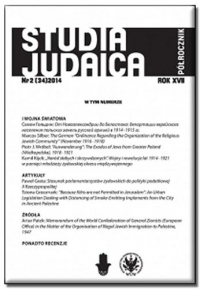MOJŻESZ MERIN – ZBAWCA, KOLABORANT CZY ZAGUBIONY CZŁOWIEK?
MOSHE MERIN: SAVIOR, COLLABORATOR OR AN ASTRAY MAN?
Author(s): Maria MisztalSubject(s): Jewish studies, Geography, Regional studies, Political history, Social history, Pre-WW I & WW I (1900 -1919), Interwar Period (1920 - 1939), WW II and following years (1940 - 1949), Fascism, Nazism and WW II, History of Antisemitism
Published by: Wydawnictwo Uniwersytetu Jagiellońskiego
Keywords: Moshe Merin; Jewish Council; Eastern Upper Silesia; forced work; resistance movement; ghettos; death camp;
Summary/Abstract: In January 1940, Moshe Merin became the Head of the Jewish Council of Elders of Eastern Upper Silesia. At this point, the community of Jews amounted to almost 100,000 members. Merin actively promoted his major concept of “survival by work.” He believed that only working for the Third Reich combined with obedience and subordination toward the aggressor can guarantee Jewish survival. This policy arose objections, especially among Jewish youth involved in the resistance movement. Until mid-1942 Merin was an influential figure. His wide contacts with the Nazis and relatively good living conditions of Jews in Eastern Upper Silesia dismissed alleged reasons for mutiny. Therefore, during the first two years of the war, the Jewish Council of Elders of Eastern Upper Silesia enjoyed a lot of success. The situation changed in 1943 when the Nazis created ghettos and started forced deportations to KL Auschwitz. The Jewish Council stopped functioning when Moshe Merin and his main associates were deported to the death camp.
Journal: Studia Judaica
- Issue Year: 21/2018
- Issue No: 42
- Page Range: 299-331
- Page Count: 33
- Language: Polish

